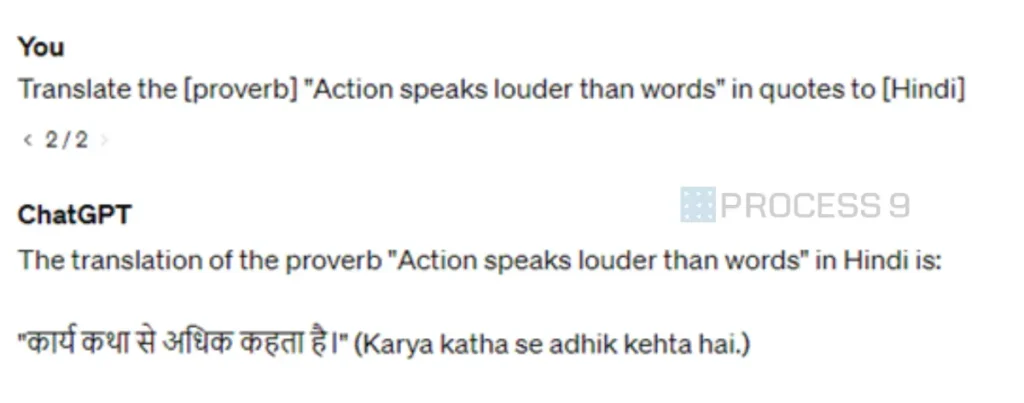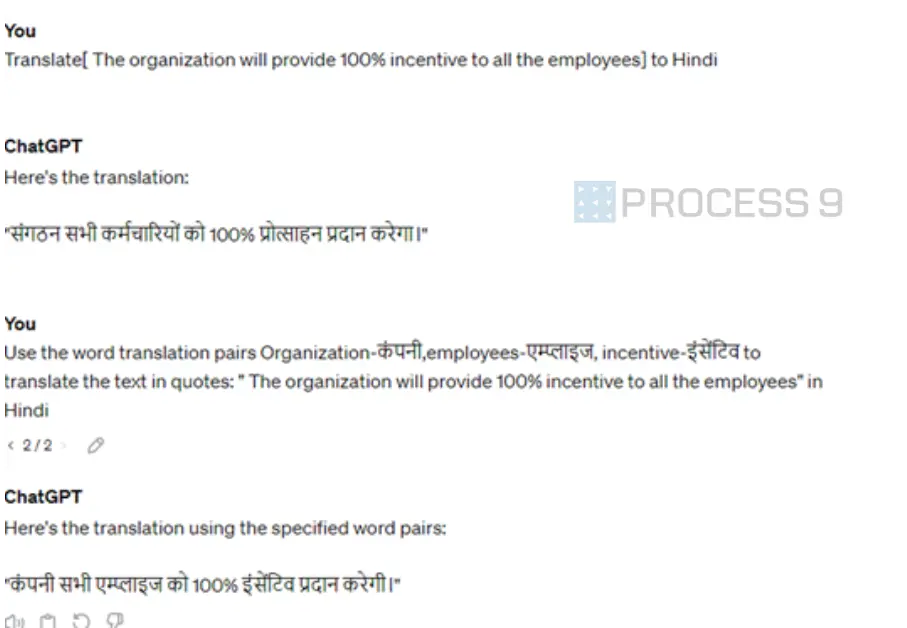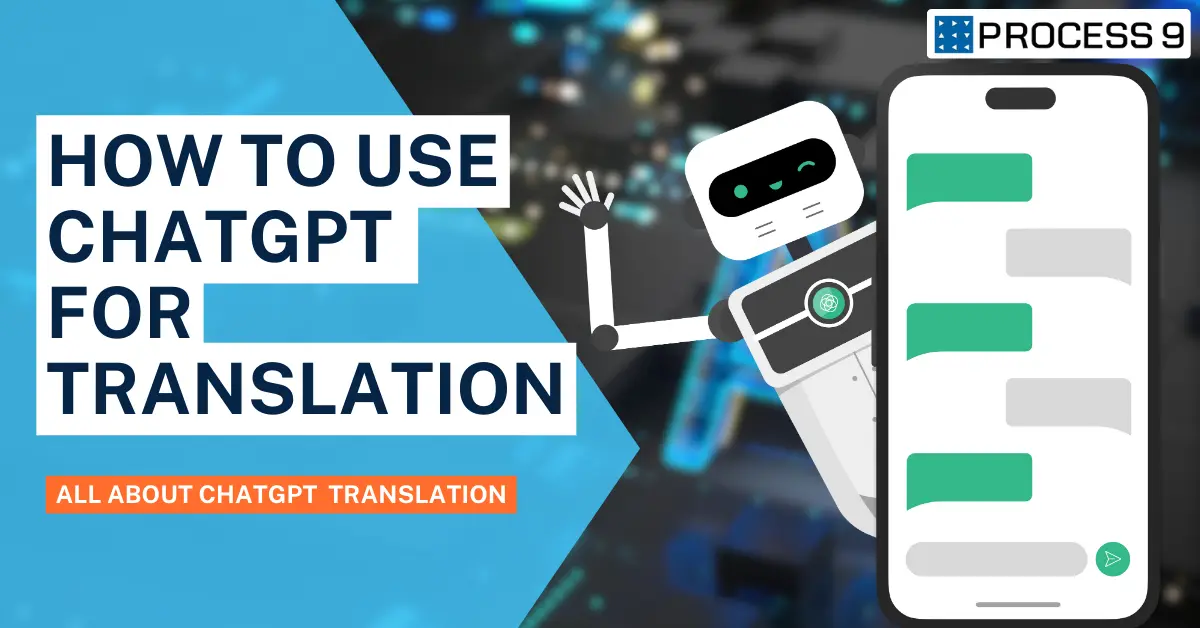Chatgpt: The Newest Frontier in translation
Chatgpt has been a game changer in the field of language technology ever since its inception in November 2022. Even though the primary objective of Chatgpt is natural language understanding and generation, this platform quickly attracted significant interest in the translation and localization industry as well. This platform has a conversational interface and comprises a large corpus of text. Since its launch, Chatgpt has shown promising translation capabilities, captivating its users with fairly accurate outputs. As of January 2024, Chatgpt supports around 80 languages out of which 15 are Indian languages namely Bengali, Bhojpuri, Marathi, Konkani, Kashmiri, Kannada, Hindi, Haryanvi, Gujarati, Oriya, Punjabi, Rajasthani, Sanskrit, Urdu and Sindhi.
In this blog, let us explore a little more about the translation potential of Chatgpt, find out if it offers better translation than Google Translate, and most importantly
How to translate using Chatgpt?
Like any other translator tool, if you provide the text to be translated and the target language, Chatgpt can deliver a translated output. However, with the right prompts, Chatgpt is capable of delivering customized translation outputs, with specific language translation scenarios. An ideal Chatgpt prompt for translation should cover the following aspects,
- Type of text
- Context of the text
- Usage of style transfer
- Provide word translation pairs
- Considering regional and cultural nuances
The type of document that needs to be translated can vary from financial documents to stories to poems and much more. To produce better results, it is necessary to specify the document type on a Chatgpt prompt. In the below example, the type of text is mentioned as a proverb in the prompt,

Many times word-to-word translation may not be appropriate for all contexts. So the contextual nuances of the text need to be considered to make the final output relatable. In Chatgpt prompts, you can add the context of the text to be translated to get better results. In the below example, you can see the variation in the output when the context is provided that the input text is a cricket commentary,

Using the style transfer feature of Chatgpt, the output can be created on various writing styles, tones, and voices enhancing its versatility.

The word translation pairs you provide in the prompts allow you to create customized outputs using Chatgpt. In the below example, you can see the variation in the output when specific word translation pairs are used during the translation

It is always possible to improve the translation by specifying the region for which the translated output is intended. There might be different meanings for certain words in different places because of the different cultures. Mentioning the target region and cultural specifications, in the Chatgpt prompt will undoubtedly improve the outcome.
Also read: Complete guide on AI localization
Is Chatgpt better than Google Translate?
Let us now determine which translator tool, Chatgpt or Google Translate, is best suited for various translation needs. A good translation is not just about conveying the literal meaning, but also preserving the tone, cultural nuances, and context. Many translation tools find it challenging to preserve the meaning, context, and colloquialism while translating between two language pairs.
For example, when you translate English idioms it is important to know the context and not just go by the literal translation of the words. Below is the translation output for certain English idioms in Google Translate, and ChatGPT. Depending on the language in which the translation is to be done, both these tools deliver literal meanings in some languages and interpretation of the idioms in others.
Also Read: Google translate alternatives


Some of the main pros and cons of Chatgpt and Google Translate are,
Google Translate:
| No | Pros | Cons |
| 1 | Google Translate supports 133 languages | The Google Translate outputs lack accuracy |
| 2 | It is easily accessible to everyone | It may store the translated data and this raises privacy concerns |
| 3 | It provides instant translations and is ideal for daily use | It doesn’t cover the context of the text to be translated |
Chatgpt
| No | Pros | Cons |
| 1 | Chatgpt has a good understanding of the context | The advanced version of Chatgpt incurs a cost |
| 2 | It can be used for versatile purposes | Chatgpt requires a little more understanding of NLP. |
| 3 | The translation tasks can be finetuned | Chatgpt supports only 80 languages |
The Final Verdict
Chatgpt outperforms Google Translate in terms of accuracy because its prompt can be easily customized when translating between language pairs. However, because Google Translate supports a wide range of languages, it is a better choice for translation in less commonly used languages. Google Translate provides commendable translation speed. Chatgpt needs more time to translate complex sentences. Google Translate does not understand the context, but Chatgpt has an advantage here. Chatgpt also provides greater control over data, thereby protecting privacy.
As a final verdict, Google Translate is ideal for on-the-go translation tasks and Chatgpt is best suited for tasks like translating documents, books, and other types of texts.
But what if you want to translate your entire website, mobile application, or software?
MoxVeda & MoxWave: Best choice for multilingual digital assets.
MoxVeda is Process9 Technologies’ AI-based language localization platform that can localize your website and mobile applications while efficiently handling both dynamic and static content. Process9 also offers MoxWave, a comprehensive neural machine translation API that can be effortlessly integrated into your system. MoxVeda is an AI-driven localization platform that can localize diverse digital assets, like websites mobile apps, software, etc. Both MoxVeda and MoxWave are highly secured. MoxWave can be trained and customized based on your business domain and language specifications. MoxVeda is compatible with all the CMS platforms and handles all major tech stacks. With MoxVeda, you have the complete liberty to choose your translation sources(machine or human), target languages, and term bases based on your requirements.
Are you ready to start your multilingual journey with your digital assets? Consult with our language experts today!







Share: